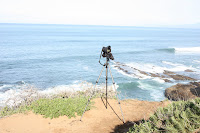


Just north of the Santa Barbara County Line, this lake is named for a skinny bear (Oso Flaco in Spanish) killed and eaten by Spanish explorer Portola's 1769 expedition party. The grizzly had been apparently been poisoned by the indigenous people and two of the Spanish party died from consuming the meat. While no grizzlies remain in California, the habitat at Oso Flaco has recovered from years of off-road vehicle use and it is now protected from the vehicles. Fall is usually the best for birding here, but it can be productive in the spring (Spring rarities have included Little Gull, Franklin's Gull and a few vagrant passerines). So, I pedalled south on Saturday, April 10, to see what I could find.
I paralleled Highway 101 for much of the trip and then took Highway 1 down to Oso Flaco Lake Road - almost 3 hours ride from Los Osos and about 2 hours pedal south from San Luis Obispo. It was difficult to pass by good-looking and sounding habitat along the way, so I could get down to the lake for as early a start as possible. Unfortunately, it was not worth the rush as Osos Flaco was cool and breezy, and the birds were not very numerous.
I spent a lot of time going through the many swallows at the lake, like the pictured Tree Swallow. I could only find Tree, Barn and Rough-winged Swallows. I scoped the lake edge for bittern, moorhen and rails, but only saw one Sora (3 others called). Some birds were busy with nests (like this Marsh Wren nest) and nest holes (like the Chestnut-backed Chickadees). I walked out on the boardwalk (pictured) across the lake and out through the sand to the beach, but the birds were even fewer (the flowers were colorful). Oso Flaco is another example of over regulation by the state - with fences and signs everywhere. (By the way, the complete re-vegetation of the dunes in this area may be good for sparrows, thrashers and wrentits, but it is not conducive to nesting of the threatened Least Tern and Snowy Plover, which are being forced even more than before into the recreational vehicle area!) It is especially ironic because from the boardwalk, surrounded by fences and signs, you can see the vehicle area where it is only bare sand and dune buggies scream over the desolate landscape.
I tried hard, but could only find one new BIGBY species here - Yellow Warbler, a common migrant in my neighborhood which I had not seen yet. I ate lunch and headed north to Oceano Lagoon and the county park pond to see if my luck might change with a Green Heron or Moorhen or some surprise.
I stopped at a market along Highway 1 in Oceano(a community with a large latino element, unlike most of this largely white non-diverse county) and got a fresh made burrito and some chocolate milk to eat at the county park while I watched grackles and gulls. Nothing more unusual than a couple of Glaucous-winged Gulls were apparent at the park. I decided to take my bike around the lagoon trail since part of it was flooded (to keep my feet dry)and to get around a little more quickly. I found some small flocks, with one large flock near the back of the campground. It included many Bullock's and Hooded Orioles with the usual warblers, but no new migrants. This trip turned out to be a good cycle workout for my legs and ribs, but only yielded one new migrant which I would have undoubtedly seen on my morning dog walks from home!
I packed later that evening for a ride the next morning, but gusting winds, dark skies, sprinkles and the forecast of rain kept me at home on Sunday. While mowing the lawn before the rain started, I saw an apparently all dark swift overhead. I ran to get my binocs, to see what it was. I ran into the street in front of my house, to get a look at as much sky as possible, and saw eight or ten small dark swifts with a slightly lighter color on the throats - Vaux's Swifts (BIGBY # 224) - a better bird than I had on my day long ride and bird the day before. I ran inside for my camera. They aren't called "swifts" for nothing; I ran around the neighborhood trying to get a decent photo and coming up only with the photo posted here. It was undoubtedly humorous to any neighbor who might have been watching as I ran around the street pointing my camera straight up in the sky, letting out little "ohs" or "ahs" as I tried to get a photo. This was interspersed with sneezes from the spring pollens followed by an "ow" as my healing ribs hurt each time I sneezed.


































